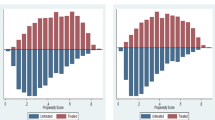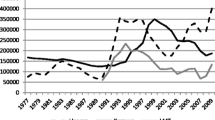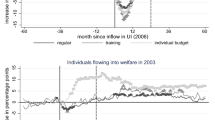Abstract
This article examines the extent to which the program activity assignments of participants in federal job training programs affect their future employment prospects. We analyze the effects of three types of programs—classroom training, on-the-job training, and work experience—on the post-program employment outcomes of black and white women and men. The data are from the Continuous Longitudinal Manpower Survey of fiscal 1976 participants in the Comprehensive Employment and Training Act (CETA). Logistic regression and event history analysis are used to assess the likelihood of immediate employment upon leaving CETA and the rates at which participants enter and leave their first post-program spells of employment and nonemployment.
Similar content being viewed by others
References
Allison, P. (1982). “Discrete-time methods for the analysis of event histories,” in S. Leinhardt (ed.), Sociological Methodology 1982. San Francisco: Jossey-Bass.
Allison, P. (in press). Event History Analysis. Manuscript prepared for Sage Publications series “Quantitative Applications in the Social Sciences”.
Bassi, L. (1983). “The effect of CETA on the postprogram earnings of participants,” Journal of Human Resources 18: 539–556.
Berryman, S., W. Chow, and R. Bell (1981). “CETA: It is equitable for women?” Santa Monica, CA: Rand Corporation.
Bloch, F. (1979). “Introduction,” in F. Bloch (ed.), Research in Labor Economics: Evaluating Manpower Training Programs, Greenwich, CT: JAI Press.
Choy, D. (1980). “Females enrolled in decentralized CETA programs.” Office of Program Evaluation, Employment and Training Administration, U.S. Department of Labor.
Congressional Budget Office and National Commission for Employment Policy (1982). CETA Training Programs: Do They Work for Adults? Washington, DC: Congressional Budget Office.
Estrada, C. (1980). Discussant, “Barriers to effectively using employment and training programs to improve the self-sufficiency of women.” Conference on the Experience of Women in Employment and Training Programs. National Commission for Employment Policy, Washington, DC, September 17–18.
Flinn, C. and J. Heckman (1982). “New methods for analyzing individual event histories,” in S. Leinhardt (ed.), Sociological Methodology 1982. San Francisco: Jossey-Bass.
Furstenberg, F. Jr. and C. Thrall (1975). “Counting the jobless: The impact of job rationing on the measurement of unemployment,” Annals of the American Academy of Political and Social Science 418: 45–59.
Goodfellow, G. (1979). “Estimates of the benefits of training for four manpower training programs,” in F. Bloch (ed.), Research in Labor Economics: Evaluating Manpower Training Programs. Greenwich, CT: JAI Press.
Hanushek, E. and J. Jackson (1977). Statistical Methods for Social Scientists. New York: Academic Press.
Harrell, F. Jr. (1983). “The LOGIST procedure,” in SAS Supplemental Library User's Guide. Cary, NC: SAS Institute.
Harlan, S. (1979). “Participation of disadvantaged groups in employment and training programs (CETA) in New York and Pennsylvania.” Final Report, Prepared for the Office of Research and Development, Employment and Training Administration, U.S. Department of Labor.
Harlan, S. (1981). “The social context of employment choice: Women in CETA.” New England Sociologist Winter: 31–39.
Harlan, S. (in press). “Federal job training policy and economically disadvantaged women,” in L. Larwood, B. Gutek and A. Stromberg (eds.), Women and Work. Vol. I. Beverly Hills, CA: Sage.
Kiefer, N. (1979). “The economic benefits from four government training programs,” in F. Bloch (ed.), Research in Labor Economics: Evaluating Manpower Training Programs. Greenwich, CT: JAI Press.
Kiiveri, H. and T.P. Speed (1982). “Structural analysis of multivariate data: A review,” in Samuel Leinhardt (ed.), Sociological Methodology 1982. San Francisco: Jossey-Bass.
Levitan, S. and G. Mangum (eds.) (1981). The T in CETA: Local and National Perspectives. Kalamazoo, MI: W.E. Upjohn Institute for Employment Research.
Marcus, S. (1980). “Influencing termination success: An evaluation of Massachusetts CETA programs.” Policy and Evaluation Division, Massachusetts Department of Manpower Development.
Masters, S. and R. Maynard (1981). The Impact of Supported Work on Long-Term Recipients of AFDC Benefits. Volume 3 of the Final Report on the Supported Work Evaluation, Manpower Demonstration Research Corporation.
Mirengoff, W. and L. Rindler (1978). CETA: Manpower Programs Under Local Control. Washington, DC: National Academy of Sciences.
National Commission for Employment Policy (1981). Increasing the Earnings of Disadvantaged Women. Washington, DC: National Commission for Employment Policy.
Perry, C., B. Anderson, R. Rowan, and H. Northrup (1975). The Impact of Government Manpower Programs. Philadelphia, PA: University of Pennsylvania Press.
Sawhney, P., R. Jantzen, and I. Hernstadt (1982). “The differential impact of CETA training,” Industrial and Labor Relations Review 35: 243–251.
Sexton, P. (1978). Women and Work. R & D Monograph No. 46, Employment Standards Administration, U.S. Department of Labor.
Simeral, M. (1978). “The impact of the Public Employment Program on sex-related wage differentials,” Industrial and Labor Relations Review 31: 509–519.
Steinberg, R. and L. Haignere (1983). “New directions in equal employment policy: Training women for nontraditional occupations through CETA.” Center for Women in Government, State University of New York at Albany.
Tuma, N. (1980). Invoking RATE. Stanford University.
Tuma, N. (1982). “Nonparametric and partially parametric approaches to event history analysis,” in S. Leinhardt (ed.), Sociological Methodology 1982. San Francisco: Jossey-Bass.
Tuma, N., M. Hannan, and L. Groeneveld (1979). “Dynamic analysis of event histories,” American Journal of Sociology 84: 820–854.
Underwood, L. (1979). “Women in federal employment and training programs.” Washington, DC: The Urban Institute.
U.S. Commission on Civil Rights (1979). Women: Still in Poverty. Washington, DC: U.S. Commission on Civil Rights.
U.S. Commission on Civil Rights (1981). Child Care and Equal Opportunity for Women. Clearinghouse Publication No. 67. Washington, DC: U.S. Commission on Civil Rights.
U.S. Department of Commerce, Bureau of the Census (1984). “Characteristics of the population below the poverty level: 1982,” Current Population Reports, Consumer Income, Series P-60, No. 144.
U.S. Department of Labor (1981). Employment and Training Report of the President. Washington, DC: U.S. Government Printing Office.
U.S. Department of Labor, Bureau of Labor Statistics (1983). Handbook of Labor Statistics, Bulletin 2175. Washington, DC: U.S. Government Printing Office.
Waite, L. and S. Berryman (1984). “Occupational desegregation in CETA programs,” in B. Reskin (ed.), Sex Segregation in the Workplace: Trends, Explanations, Remedies. Washington, DC: National Academy Press.
Westat, Inc. (1977). “Continuous Longitudinal Manpower Survey: Methodology,” Technical Report No. 1. Rockville, MD: Westat, Inc.
Westat, Inc. (1980). “Characteristics of enrollees who entered adult-oriented CETA programs during fiscal year 1978,” CLMS Report No. 10. Rockville, MD: Westat, Inc.
Westat, Inc. (1981). “Impact on 1977 earnings of new FY 1976 CETA enrollees in selected program activities,” Net Impact Report No. 1. Rockville, MD: Westat, Inc.
Women's Work Force (1979). “Shortchanged and slighted: An assessment of the Department of Labor's national response to women's employment and training needs.” Washington, DC: Wider Opportunities for Women.
Zornitsky, J. and M. McNally (1980). “Measuring the effects of CETA on women: Issues in assessing program performance.” Conference on the Experience of Women in Employment and Training Programs, Washington, DC, National Commission for Employment Policy, September 17–18.
Author information
Authors and Affiliations
Additional information
This research was supported by the National Science Foundation, Grant No. SES-8023042. We thank Paul D. Allison, Scott Long, William T. Markham, Joseph H. Pleck, Zick Rubin, the editor, and an anonymous reviewer for helpful comments on the manuscript. Arlene Rozzelle was research assistant on the project. An earlier version of this paper was presented at the 1984 annual meeting of the American Sociological Association in San Antonio, Texas.
Rights and permissions
About this article
Cite this article
Harlan, S.L., Hackett, E.J. Federal job training programs and employment outcomes: Effects by sex and race of participants. Popul Res Policy Rev 4, 235–265 (1985). https://doi.org/10.1007/BF00146656
Issue Date:
DOI: https://doi.org/10.1007/BF00146656




